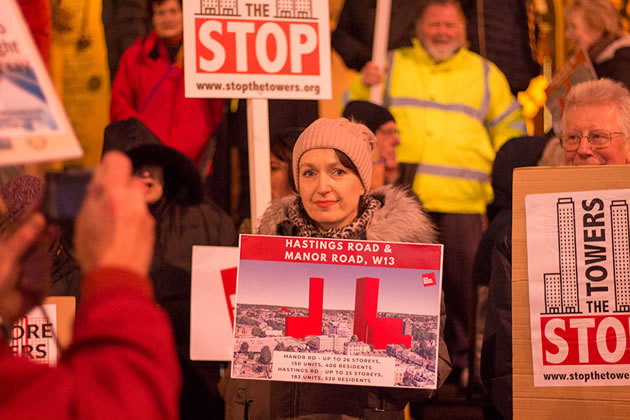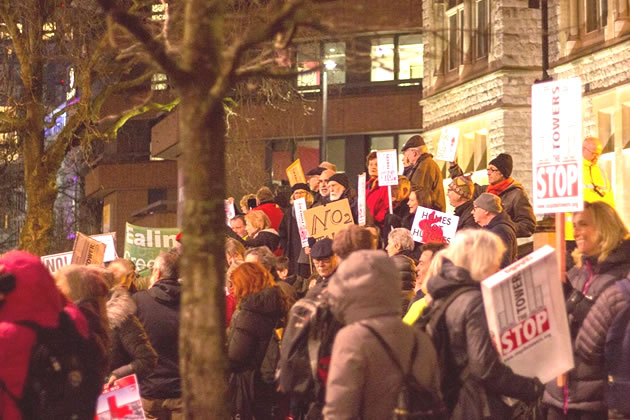Describes current situation as like a land grab in the Wild West

Tustine Sullivan protesting in February 2020. Picture: Pino Agnello
Ealing has a long-held reputation for being ‘Queen of the Suburbs’, but some residents have been increasingly alarmed at the number of tower blocks rising into the sky in recent years.
Clusters of campaign groups exist trying to fend off development they believe is harmful to the area, and the latest to the scene is Stop the Towers, initially set up in 2019.
Justine Sullivan and Denise Colliver, co-chairs of the umbrella group, were residents unaware of the huge planning battle going on in Ealing, until plans to build 25 and 26-storey buildings “within 80 metres of each other” near their West Ealing homes prompted them to act.
They both knew the Hastings Road and Manor Road sites were ripe for development with the promise of Crossrail, and the community was looking forward to improvements to the area. But they believed the specific site guidance detailing any units should not be more than four storeys.
So rocking up to a consultation to hear more about the developer’s plans, Justine said, “People pretty much had a heart attack,” with Denise adding, “You can imagine how apoplectic we were being told it was 25 storeys.”
Stop the Towers was born through the coming together of residents’ associations and began putting up posters trying to engage other residents, started a Facebook group, built up a database of supporters and organised public meetings.
And famous red block graphics of what development planned for Ealing would look like in relation to each other was also created by Justine who didn’t like that the plans for the two towers were like “pretending the other didn’t exist”.
“We are the kind of people that clean the roads, sweep the streets, help the police, we do lots of stuff round here and suddenly we are being told to keep our nose out when it comes to planning,” the 49-year-old said.
“They are trying to make out it’s this small tower but it’s actually the same size as Big Ben.”

Protesters gather at Ealing Town Hall in February 2020. Picture: Pino Agnello
In October last year, the Manor Road development – which was reduced to 20 storeys in size – was rejected by councillors at Ealing Council’s planning committee in a victory for the campaigners.
More than 2,700 people objected to the plan, but despite the huge public outcry during the pandemic when campaigning was limited to flyering and online, Justine is wary the vote was still “really tight”. They also felt blamed by councillors for the level of letters and emails they received over the planning application, including for “rude” correspondence.
“You could say it was a success,” she said, but, “It was awful, that was a terrible experience.”
But the tower blocks opened their eyes to the planning system and realised that the “full-time job” of campaigning couldn’t stop there.
Justine said, “The aim wasn’t ‘let’s fight Ealing Council on all these towers,’ but the more you peeled back the more you realised how appalling it was…
“Seems to me any bit of land in Ealing is up for grabs, it’s like land grab for the wild west.
“It revealed a lot more and tapped into a lot of people already quite angry.”
For Denise, she says she’s learnt a “huge amount” about planning in the short while campaigning, but she’s adamant the system is broken and “a nightmare” for an ordinary person with no background in planning and architecture to get involved with the planning process.
“It’s virtually impossible unless you are fortunate enough to have people who have professional experience which fortunately Stop The Towers has people that have had both the time and experience go through them with a fine tooth comb, and that has taken hours,” she said.
“It’s a professional full-time job to do that.”
She also feels for some areas of Ealing that have already seen huge levels of development, adding, “I feel really sorry for people in East Acton as they have ended up in Manhattan on their doorstep.
“That is disgusting and appalling.”
Social housing is also a key area that shocks Denise. According to research tracked by campaigners in five years 1,237 council homes have been demolished or lost, while 31 council homes or social housing have been built.
The 60-year-old explains the mayor’s London Affordable Rent (LAR) is often equated with traditional social rent, but this is not the case, with ‘proper’ council housing is much cheaper than LAR due to not being valued against what full market price is. With LAR, service charges for the upkeep of the development and concierge, for example, are also extra bills on top of the rent.
“It’s almost like social cleansing and that I find appalling that a Labour council is actually making it virtually impossible for low income families to live in central Ealing,” she added.
In 2018, Ealing Council committed to building 2,500 ‘genuinely affordable’ homes in the borough by April 2022. This means London Affordable Rent and London Living Rent as being available for social rent tenants.
Council bosses said in November 2020 that nearly 1,500 of these homes have been built so far, and announced ambitions of its housing development company Broadway Living to build at least 1,300 new affordable homes in the next six years.
Unveiling the multi-million-pound plan, housing and planning boss Mik Sabiers said, “This plan, which will ultimately pay for itself, will create a supply of sustainable, high-quality, energy-efficient, affordable homes for Ealing for decades to come.
“One serious concern which has been drawn into sharp focus by the coronavirus pandemic is the impact that poor housing has on health. These new homes will make a real difference to the quality of life of the people who live in them. ”
But for Justine and Denise, they fear the “mismatch” plans and lack of “joined-up” thinking for Ealing are threatening the future of sustainable, healthy communities in the borough.
Ealing Council’s core strategy of its Local Plan, which sets out the vision of future development in the borough, was first set in 2012 to run until 2026. But campaigners blast it for not being reviewed to stay up to date, meaning decisions are being made on developments without a wider plan in place to shape Ealing’s future.
Denise said, “We now feel our trust has been breached and the council is no longer doing things that are appropriate.”
The campaigner fears the trend of high rises is repeating mistakes of past decades, where it has been acknowledged in social studies that tower blocks “do not create healthy neighbourhoods,” and are “not good for children”.
She says the council “isn’t listening in so many aspects”, and as “Joe average, we feel powerless”.
Justine added, “I think there’s a place for tall towers but you don’t build a cottage on the M40…
“We are not going anywhere, I’m not going to move out. Work with people, work with the community what would be best what would fit in for the people that live there.
“We know it’s [West Ealing] is going to be developed, let’s not abuse it, let’s make it good. Not just for the people that are making the money.”
The borough’s planning battleground is currently focused in the heart of Ealing, at the local authority’s own headquarters Perceval House.
The Uxbridge Road site is up for redevelopment in a joint venture project by the council and Vistry Partnerships, but again has faced public backlash with more than 1,700 objections online and an intervention from Labour MP for Ealing Central and Acton Rupa Huq.
Plans include the demolition of the existing council building to make way for new council offices, commercial space, 477 homes, and a 26-storey tower block.
On February 17, Ealing Council’s planning committee deferred the plans to be revised, due to concerns over just seven homes being family-sized three-bedroom flats, out of the whole 477-home development.
But much to the surprise of the community, the application is going back to committee on 10 March, just four weeks later, with changes to include 28 three-bedroom flats instead. They will make up 12 per cent of the total affordable homes in the development.
“You’ve got to ask yourself, what’s the rush?” says Justine.
Campaign group Save Ealing Centre has been on the scene since 2007, again pooling together local resident’s associations and users of the town centre concerned about its future.
Chair Will French said, “The feeling is it’s been poorly planned and piecemeal and actually left the centre a less attractive place than it used to be, that’s been our overriding concerns.”
And the group has worked with the “younger” and “more vigorous” Stop the Towers to coordinate efforts against the redevelopment of Perceval House.
“Everyone’s worried if Perceval House goes through it is going to establish a precedent for tall buildings from West Ealing all the way to central Ealing,” Will said.
“It sets the tone once the Perceval House will create that precedent they will be able to build a cluster of tall buildings around it, that is something people who know Ealing will feel is not in keeping with the character and the conservation areas.”
Will also feels a lot of other residents’ concerns about the development did not get addressed at the meeting and will not have been changed for the revised plans.
“People feel fairly helpless when dealing with a council so determined,” he added.
While he believes it is likely the tweaked application will be approved by councillors next week, the referral of the development to the Mayor of London, and central government, is still an opportunity to make their voices heard.
“[Ealing’s] Queen of the suburbs is what we say, it’s a suburban centre, it’s a historic centre, it’s important to respect and reflect its history rather than sweep it away which is what the council in so many of the proposals seem determined to want to do,” he said.
“The council has done what suits its short term interests and completely disregarded the longer term interests of Ealing as a historic centre for local people.
“We are going to be challenging that right through the system.”
Not all however may see eye-to-eye with hopes to preserve Ealing’s suburban atmosphere.
As made clear by a representative for Perceval House applicants, Sarah Parkinson, in favour of the redevelopment, she said, “In response to the concern of changing the character of an area, I don’t need to tell you how much Ealing has changed in the last 10 years, Ealing Broadway is a busy town centre at the heart of a growing borough with rapid access to central London.
“Ealing is a borough with a history of growth and change, it’s an area that’s moving quickly not standing still, we believe this development responds to that.”
A further indication that the borough’s vision is changing may have been given last year when former housing cabinet member Peter Mason said the council was scrapping Ealing’s name of “Queen of the Suburbs”, describing it as “backward looking.”
He added, “[It’s] wistful of a bygone age that never existed, given the diversity of towns, employment and industrial history of our borough. (Or at least that’s what was suggested)”.
Anahita Hossein-Pour - Local Democracy Reporter
March 9, 2021